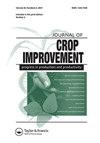Screening of rice blast resistance in Thai upland rice using pathogenicity assays and molecular markers
IF 1.5
Q3 AGRONOMY
引用次数: 0
Abstract
ABSTRACT Rice blast disease caused by the fungus Pyricularia oryzae is one of the most devastating diseases of rice (Oryza sativa L.). Therefore, the use of resistant rice varieties would be the most effective way to control this disease. Based on disease evaluation, upland rice varieties were classified into two groups: resistant (35%) and moderately resistant (65%). Forty upland rice varieties and two lowland rice varieties were genotyped for seven major rice blast resistance genes Pi37, Pid2, Pi9, Pi36(t), Pi5, Pik-m, and Pi54. The gene frequencies of the seven major R genes ranged from 2.38% to 100%. The 42 varieties contained one to five R genes. Two varieties had five blast resistance genes, whereas 21 varieties contained four R genes, 15 varieties contained three R genes, 3 varieties contained two R genes, and only one variety contained one R gene. Furthermore, the relationship between the presence of different R genes and disease reactions was investigated using a multiple stepwise regression model. Three markers, Pi5, Pi54MAS, and Ckm2, for three R genes (Pi5, Pi54, and Pik-m) were moderately correlated with blast disease with partial correlation coefficients of 0.35 to 0.47. These results provide new sources of resistance genes for designing future breeding program to develop leaf blast-resistant rice varieties.利用致病性分析和分子标记筛选泰国陆稻抗稻瘟病性
摘要稻瘟病是由稻瘟病菌引起的最具破坏性的水稻病害之一,因此,利用抗性水稻品种是防治稻瘟病的最有效途径。根据病害评价,旱稻品种分为两组:抗性(35%)和中度抗性(65%)。对40个陆稻品种和2个低地稻品种的7个主要抗稻瘟病基因Pi37、Pid2、Pi9、Pi36(t)、Pi5、Pik-m和Pi54进行了基因分型。7个主要R基因的基因频率在2.38%到100%之间。42个品种含有1到5个R基因。2个品种有5个抗稻瘟病基因,21个品种有4个R基因,15个品种有3个R基因;3个品种有2个R基因。此外,使用多元逐步回归模型研究了不同R基因的存在与疾病反应之间的关系。三个R基因(Pi5、Pi54和Pik-m)的三个标记Pi5、Pi54MAS和Ckm2与稻瘟病中度相关,偏相关系数为0.35至0.47。这些结果为设计未来的抗叶瘟病水稻品种育种计划提供了新的抗性基因来源。
本文章由计算机程序翻译,如有差异,请以英文原文为准。
求助全文
约1分钟内获得全文
求助全文
来源期刊

Journal of Crop Improvement
Multiple-
CiteScore
3.30
自引率
7.70%
发文量
42
期刊介绍:
Journal of Crop Science and Biotechnology (JCSB) is a peer-reviewed international journal published four times a year. JCSB publishes novel and advanced original research articles on topics related to the production science of field crops and resource plants, including cropping systems, sustainable agriculture, environmental change, post-harvest management, biodiversity, crop improvement, and recent advances in physiology and molecular biology. Also covered are related subjects in a wide range of sciences such as the ecological and physiological aspects of crop production and genetic, breeding, and biotechnological approaches for crop improvement.
 求助内容:
求助内容: 应助结果提醒方式:
应助结果提醒方式:


